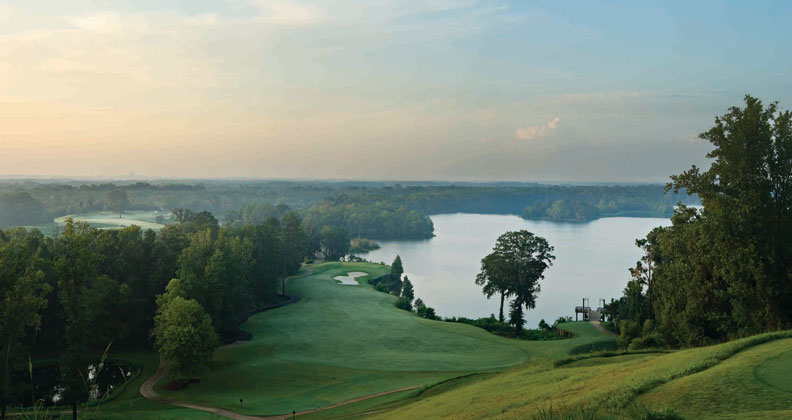Robert Trent Jones Golf Trail – 100 Miles In Jones’ Shoes
By E. Nolan
There is nothing else like it in America. No more unique of an original vision. No more successful of a business model. If the opinion of millions of golfers mattered as much as those few picked to pen the world’s history books, Dr. David Bronner would be regarded in the same genius light as Albert Einstein, Sir Isaac Newton and Alexander Graham Bell.
Twasn’t an apple falling from a tree, but a golf ball being hit from a tee that caused the Minnesota native to uproot and move south to a place you can play all year… to sew the idea of a statewide golf trail and nurture it through to fruition. The results have benefitted far more than the aforementioned “millions of golfers.” For over twenty years now the Trail has financially sustained not just its 1000+ full-time employees, but subsidized the entire Retirement Systems of Alabama. Everyone won… and continues to win in Alabama (not just the Crimson Tide). And that was the point from the outset.
This was either going to be a monumental success or failure. Dr. Bronner knew they couldn’t just dip a toe in… they needed to cannonball. There was going to be criticism, hand wringing, and finger pointing. There would be a lot of anger. He was going to have to preach a lot of patience, and wield off a number of psychologists. Dr. Bronner was essentially Jack with the magic bean. He knew what it could be if they just planted it. He believed it could slow or stop all the motorists – many of them his fellow snowbirds – cruising through Alabama to spend their money in Florida. He believed it would work if everyone bought in.
Fortunately they did. The state endorsed Dr. Bronner’s plan and began the process. Step one should have been the easiest – finding an architect. But no one would pick up the phone. Who knows why Mr. Jones did? All that matters is he did, and the Trail accordingly took on his name. To say “the rest is history” would be both cliché and wrong, as there is so much more potential in the Trail’s future. Its model has been duplicated and triplicated to a number of extremes across the country, though none with remotely the same degree of success. Perhaps it couldn’t even be done again in today’s America – in today’s golf economy. Who knows? (Though I’d certainly be in favor of a David McLay Kidd trail in the Pacific Northwest.)
Eleven Trail sites and 26 courses were plotted deliberately across the state to form a brilliant constellation of golf stars. Each site has anywhere from 18 to 54 holes – 55 if you include the clubhouse restaurants – for a grand total of 468 holes. Four of the sites have 18-hole Par 3 “Short Courses” (Par 54 overall) and three more sites have “Short Nines” to go with 27 regulation holes. On the opposite extreme some of the courses are built to mammoth lengths, like Fighting Joe’s 5-mile cross-country template. (8,200 yards to be exact.) On course, the Trail is 172,398 yards of golf from the tips. 98 miles. And off the course – full circle – the Robert Trent Jones Golf Trail is 1,078 miles by car. Those are the remarkable facts.
It would make sense for a trail with such a uniform construction plan to have a similar foundation in lodging. Marriott has made that the case. One of the elite hoteliers in the industry, Marriott’s standards perfectly matches the similarly lofty expectations of the Trail’s organizers. Marriott has eight classy hotels, known as “the Resort Collection,” paired up with seven of the Trail’s eleven hubs. Three of these hotels were recently honored among the “Top 500 Hotels in the World.” Many of them have too many amenities to list – though the waterparks and fantastic dining options do merit their mention.
At this point in the article you could be thinking to yourself, “It sounds nice… maybe too nice. But is it really all of that? It can’t be. Can it?”
Yes. It is. All that and a bag of chips. (Kids probably don’t say that anymore.) If you’re from Minnesota, you’ve seen the Trail billboards all over. If you’re like me, you’ve probably wondered why there are so many of those signs… and what could possibly be so alluring about Alabama. I had to find out. A year ago my son and I drove down and golfed at all eleven facilities – we played a total of 286 of the Trail’s golf holes. What we found was uniform exceptional conditioning, service on par with or exceeding that of all the other area courses but FarmLinks (near Birmingham), and anything but replicated course designs. The four major topographical regions of the state of Alabama were not only stunning in their beauty and diversity, but responsible for a great deal of the dramatic variety in RTJ’s fantastic designs. You could have put me in the “unbeliever” category – or skeptic – before that two-week journey. Now, like Shrek, I’m a believer.
Here’s a quick run-through of the properties and a few fun facts.
Northwest: The Shoals near Florence has two courses, Fighting Joe and the Schoolmaster. Fighting Joe was the first course on the Trail to break 8,000 yards and did so by two football fields. The host Marriott, adjacent the magnificent Wilson Dam, features Alabama’s only revolving diner, the best kids meal, and the Swamper Burger – a fried green tomato masterpiece.
North Central: Hampton Cove in Huntsville has 54 holes. The mostly flat River course is the only one on the Trail without a bunker. The roller coaster Highlands course has a 526-yard uphill hole (#9) that feels more like 1,760.
Central: Ross Bridge in Birmingham is, in my opinion, the #1 course in Alabama – the one “must play.” The Coca Cola BBQ Burger in the clubhouse is a “must eat.” Also on site, the Trail’s “Castle,” the Renaissance, is a 4-Diamond “must stay.” Oxmoor Valley is also in Birmingham two miles from Ross Bridge – with 54 more holes. Not far from Birmingham Silver Lakes has a beauty, the Trail’s best 9-hole “Short” course, and three regulation beasts titled: Mindbreaker, Heartbreaker, and Backbreaker. You get the idea.
East Central: Robert Trent Jones, Sr. considered Grand National “the single greatest site for a golf complex ever.” Seems the public agrees. The most popular host for golf groups on the Trail. 32 of the 54 holes touch Lake Saugahatchee, and you can see it from many more. I got my first hole-in-one on the Short Course (#6).
Southeast: Highland Oaks in the “Peanut Capital of the World” has four varied nines, including a “short” nine.
South Central: Capitol Hill in Montgomery has 54 championship holes and one of the two most stunning tee shots in Alabama (only #5 at FarmLinks compares) #1 at the Judge is a photographer’s dream. (Imagine hitting golf balls off the Golden Gate Bridge.) Just south of Montgomery, Cambrian Ridge has the Trail’s most entertaining driving range, 36 holes, and an Augusta National aura.
Southwest: Magnolia Grove’s Crossings course hosts the LPGA Tour each spring. The Falls course is the only Par 71 on the Trail. There’s also a “Short” eighteen. Lakewood Golf Club in Point Clear has 36 championship holes. It was the only Trail “add on” and sits adjacent another of the Trail’s marquee hotels – The Grand. (My other “must stay.”)
Aristotle claimed, “the whole is greater than the sum of its parts.” Given the unique and exceptional qualities of each site on the Trail, I believe that Dr. Bronner and Robert Trent Jones Sr. have provided golfers with the exception to that rule.









